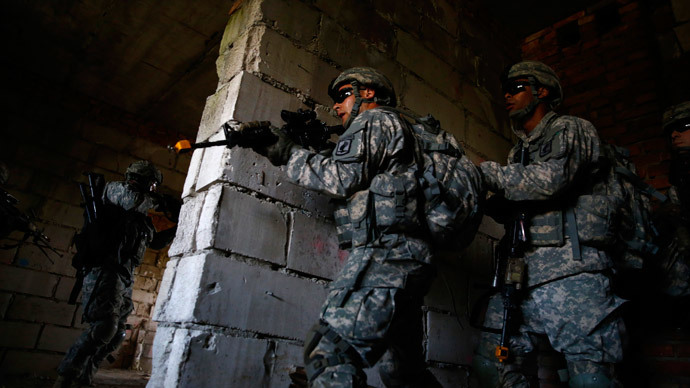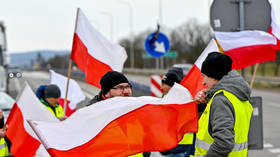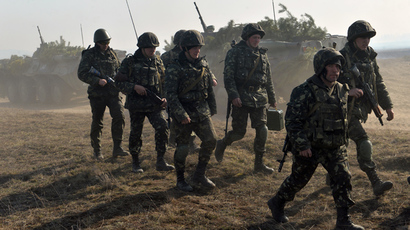US commandos get permanent Eastern European foothold

American special operations units permanently deployed in Eastern Europe are no longer just on the Pentagon’s wish list. About 100 instructors are set to train spec ops teams in former Soviet bloc states to ‘message’ Moscow over the conflict in Ukraine.
Russia launches Baltic drills alongside NATO Saber Strike war games
Tanks, troops, jets: NATO countries launch full-scale war games in Baltic
The latest statements from the US European Command (EUCOM) once again prove that Washington is using the crisis in Ukraine to revitalize the NATO alliance and bolster its military presence in Europe in order to tie it to the US.
EUCOM said in a statement that its Special Operations Command Europe (SOCEUR) “increased the size and scope of its planned exercises” following the bloody developments in Ukraine to send a “message to Moscow.”
Though American commandos have always been present at alternating military trainings in Eastern Europe, now they plan to take up quarters there, reports Reuters.
SOCEUR spokesman Lieutenant-Colonel Nick Sternberg acknowledged that “Training with our partners in their home countries is something that we have always done.”
“The difference is that now we will maintain a [permanent] Special Operations Forces presence in theater along the eastern front of NATO on this training mission,” Sternberg explained.
American special forces instructors are going to be stationed on the territory of the new NATO members states to train local special forces the urban combat tactics, wet boat exercise during mock assault raids, airdrops and drilling the visual gunnery spotters.

The crisis over federalization of Ukraine has been going for two months now and so far country’s regular troops and National Guards have been unable to suppress the defenses of pro-federalist insurgents in the Russian-speaking eastern regions.
The battles in Ukraine exposed that self-defense militia can successfully counter regular troops, and even manage to shoot down assault helicopters and fighter jets, as well as burn APCs with Soviet-made RPGs. The true number of Ukrainian servicemen who have died in the clashes remains unpublished.
To prevent such a scenario on NATO borders – and in new NATO member states - the US wants its special forces instructors to train counter-insurgency specialists in such eastern Europe countries as the Baltic States and Poland, dealing with a possible Ukrainian scenario and also putting American commandos as close to Russia’s borders as possible.
The Americans have been training troops in Estonia, Latvia, Lithuania and Poland for many years now. Every year a whole set of international war games is being conducted in Europe with military from the above-mentioned states unfailingly present.
In May and June there are five joint international military drills held in Europe. ‘Exercise Flaming Sword’ in Lithuania, ‘Exercise Combined Resolve’ in Germany and ‘Saber Strike’ ground forces exercise conducted in all three Baltic States coincided with ‘Baltic Host 2014’ and ‘Baltops 2014’ naval drills.
Such drills always bring together special troops from the participant NATO member countries.
Yet still the skills of special units from Baltic States are not close to those of the US Navy SEALS, Delta Force or Britain's Special Air Service (SAS).
“They are still not up to US, British or French capabilities, but some of the newer NATO special forces are improving very quickly," Linda Robinson, an expert in special forces at the RAND Corporation think tank, told Reuters.
Some units from the new NATO member states also took part in the Afghan campaign, like Poland's GROM special unit.

During his recent European tour, American President Barack Obama promised to defend the ‘territorial integrity’ of countries like Estonia, Latvia, Lithuania, Poland and Romania, without specifying which enemy might impinge upon it.
Obama told newly-elected Ukrainian President Petro Poroshenko that Washington would find new ways to bolster Ukrainian military, like sending military instructors to the country.
It’s hard to imagine that the US could send their special forces to help Ukrainian government deal with federalist insurgency in the east of the country, but American instructors could train Ukrainian special units to do that work instead.
So far EUCOM has firmly stated that no US forces have been deployed to Ukraine and that no Ukrainian troops are involved in special forces training in Eastern Europe.
American special forces have been extensively used in the Iraqi and Afghan campaigns, usually operating behind enemy lines, conducting reconnaissance and performing clandestine operations against Al-Qaeda and Taliban forces.
Since the 9/11 terrorist attack, American special forces have doubled in number, with the budget tripling and the number of operations expanding fourfold.














